-

新人教版高中英语选修2Unit 4 Reading for writing教学设计
假定你是英国的Jack,打算来中国旅行,请你给你的中国笔友李华写一封信,要点如下:1.你的旅行计划:北京→泰山→杭州;2.征求建议并询问他是否愿意充当你的导游。注意:1.词数80左右(开头和结尾已给出,不计入总词数);2.可以适当增加细节,以使行文连贯。参考词汇:故宫 the Forbidden City;泰山 Mount TaiDear Li Hua,I'm glad to tell you that 'm going to visit China.First,I am planning to visit Beijing,the capitalof China,where I am looking forward to enjoying the Great Wall,the Forbidden City and somebeautiful parks.Then I intend to go to visit Mount Tai in Shandong Province.I've heard that it is one ofthe most famous mountains in China and I can't wait to enjoy the amazing sunrise there.After that,I amalso going to Hangzhou.It is said that it is a beautiful modern city with breathtaking natural sights,among which the West Lake is a well- known tourist attraction.What do you think of my travel plan? Will you act as my guide? Hope to hear from you soon.

新人教版高中英语选修2Unit 4 Using langauge-Listening教学设计
The theme of the listening section is " talking about scenery and culture along a journey."The part is designed to further lead the students to understand Canadian natural geography and social environment, and integrated into the cultural contrast by mentioning the long train journey from Beijing to Moscow routes. On this basis, the part activates students related travel experience, lets the student serial dialogue, guides the student to explore further the pleasure and meaning of the long journey, and Chinese and foreign cultural comparison.The part also provides a framework for the continuation of the dialogue, which is designed to provide a framework for students to successfully complete their oral expressions, and to incorporate an important trading strategy to end the dialogue naturally.1. Help students to understand and master some common English idioms in the context, and experience the expression effect of English idioms.2. Guide the students to understand the identity of different people in the listening context, and finish the dialogue according to their own experience.3. Instruct the students to use appropriate language to express surprise and curiosity about space and place in the dialogue, and master the oral strategy of ending the dialogue naturally.1. Instruct students to grasp the key information and important details of the dialogue.2. Instruct students to conduct a similar talk on the relevant topic.

新人教版高中英语选修2Unit 5 Learning about Language教学设计
The purpose of this section of vocabulary exercises is to consolidate the key words in the first part of the reading text, let the students write the words according to the English definition, and focus on the detection of the meaning and spelling of the new words. The teaching design includes use English definition to explain words, which is conducive to improving students' interest in vocabulary learning, cultivating their sense of English language and thinking in English, and making students willing to use this method to better grasp the meaning of words, expand their vocabulary, and improve their ability of vocabulary application. Besides, the design offers more context including sentences and short passage for students to practice words flexibly.1. Guide students to understand and consolidate the meaning and usage of the vocabulary in the context, 2. Guide the students to use the unit topic vocabulary in a richer context3. Let the students sort out and accumulate the accumulated vocabulary, establishes the semantic connection between the vocabulary,4. Enable students to understand and master the vocabulary more effectivelyGuiding the Ss to use unit topic words and the sentence patterns in a richer context.Step1: Read the passage about chemical burns and fill in the blanks with the correct forms of the words in the box.

新人教版高中英语选修2Unit 5 Reading and thinking教学设计
The theme of this activity is to learn the first aid knowledge of burns. Burns is common in life, but there are some misunderstandings in manual treatment. This activity provides students with correct first aid methods, so as not to take them for granted in an emergency. This section guides students to analyze the causes of scald and help students avoid such things. From the perspective of text structure and collaborative features, the text is expository. Expository, with explanation as the main way of expression, transmits knowledge and information to readers by analyzing concepts and elaborating examples. This text arranges the information in logical order, clearly presents three parts of the content through the subtitle, accurately describes the causes, types, characteristics and first aid measures of burns, and some paragraphs use topic sentences to summarize the main idea, and the level is very clear.1. Guide students to understand the causes, types, characteristics and first aid methods of burns, through reading2. Enhance students’ ability to deal withburnss and their awareness of burns prevention3. Enable students to improve the ability to judge the types of texts accurately and to master the characteristics and writing techniques of expository texts.Guide students to understand the causes, types, characteristics and first aid methods of burns, through readingStep1: Lead in by discussing the related topic:1. What first-aid techniques do you know of ?CPR; mouth to mouth artificial respiration; the Heimlich Manoeuvre

新人教版高中英语选修2Unit 5 Using langauge-Listening教学设计
The theme of this section is to learn how to make emergency calls. Students should learn how to make emergency calls not only in China, but also in foreign countries in English, so that they can be prepared for future situations outside the home.The emergency telephone number is a vital hotline, which should be the most clear, rapid and effective communication with the acute operator.This section helps students to understand the emergency calls in some countries and the precautions for making emergency calls. Through the study of this section, students can accumulate common expressions and sentence patterns in this context. 1.Help students accumulate emergency telephone numbers in different countries and learn more about first aid2.Guide the students to understand the contents and instructions of the telephone, grasp the characteristics of the emergency telephone and the requirements of the emergency telephone.3.Guide students to understand the first aid instructions of the operators.4.Enable Ss to make simulated emergency calls with their partners in the language they have learned1. Instruct students to grasp the key information and important details of the dialogue.2. Instruct students to conduct a similar talk on the relevant topic.Step1:Look and discuss:Match the pictures below to the medical emergencies, and then discuss the questions in groups.
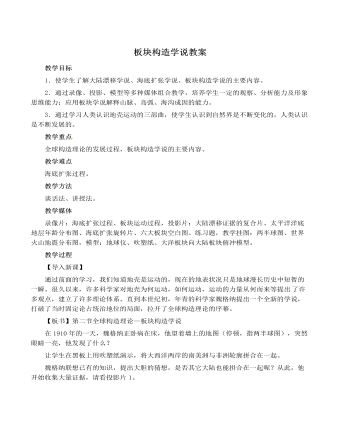
人教版高中地理选修1板块构造学说教案
【启发想象 】能否将刚才讲的内容用一个游泳动作形容一下?这好像蛙泳动作。我们大家一起做:熔岩冒出(双手合十向上)→推向两边(双手向两侧分开)→遇陆俯冲(双手往下)→重熔再生(双手相向合并向上)。【小结板书】二、海底扩张学说前面我们学习了两个假说,整理一下已知条件:事实证明大陆是在漂移的,如欧洲与美洲的距离在扩张,但是漂移的动力不足;海底是不断扩张的,有生长与消亡。能否在前人研究的基础上,提出更准确更合理的假设呢?一个新的理论诞生了,它是目前最盛行、最活跃的全球构造理论【板书】三、板块构造学说1.板块概念学生读书。【启发提问】板块“漂移”与大陆“漂移”的位置有何不同?学生回答。板块漂移是指岩石圈漂在软流层上,大陆漂移发生在地壳两层之间。【提问】板块是如何划分的?读图用半分钟记下六大板块的位置和名称(提示:按大洲和大洋名称记忆)。
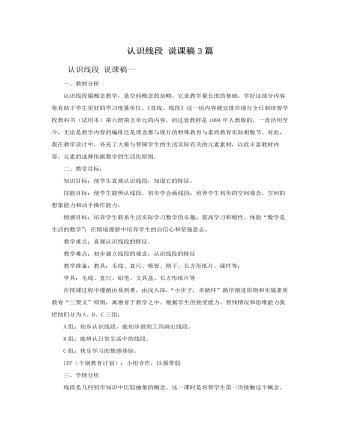
人教版新课标小学数学二年级上册认识线段 说课稿3篇
一.创设情境,解决问题。(一)直观认识1.请每个同学举起手中的毛线。说说你的毛线和其他同学有什么不一样。(学生会观察到有长短,颜色,粗细的不一样。)设计这个环节是为了让学生先找出线段的非本质特征。只有去掉了非本质特征,学生才能更明确到记住线段的本质特征。)2.请每个同学在认真观察,说说你的毛线和其他同学的有什么是一样的。这个环节学生最基本能发现手中的毛线是直的。(二).讲解概念1.通过直观的认识后,由教师讲解线段这个概念:像我们刚才手中这一条直直的毛线,就可以看做是线段。(这句话的讲解中,教师要突出直直的,这是线段的最基本特征,还有一个词是是看做是,数学的是严谨的,不能说这条毛线是线段,并让学生也举起毛线和老师一起说说这句话。)
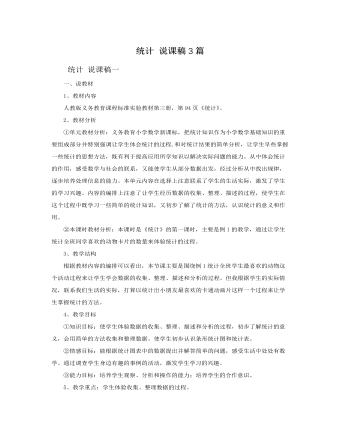
人教版新课标小学数学二年级上册统计 说课稿3篇
统计是一种数学思想,也是认识客观事物常用的一种方法。让学生学习统计,要引导他们经历收集、整理数据的过程,精力把整理出来的数据用图表形式表现出来的过程,经历对统计的数据进行分析、判断的过程,从中理解并掌握一些有关统计的基础知识和基本技能,学习解决实际问题。(一)新的课程标准要求我们的数学课程应体现基础性、普及性和发展性。要强调从学生已有的生活经验出发,要使学生学有价值的数学,这些内容要有利于学生主动地进行观察、实验、猜测、验证、理解与交流等数学活动。(二)本课的教学通过学生积极参与数学活动,合作交流,力求体现人人学有价值的数学,体现数学就在我们的身边,与我们的学习生活紧密相联,体会统计的目的和意义,掌握统计的方法,体验数学学习的乐趣。
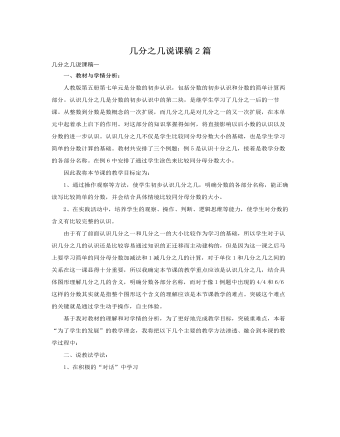
人教版新课标小学数学三年级上册几分之几说课稿2篇
二、教法运用分数在日常生活中经常出现,但学生对它的认识却各不相同。新课程标准视学习为“做”的过程、“经验”的过程,凸现学生学习的实践性特点。因此,本课的设计力求在教法上体现“在玩中学,在做中学,在合作交流中学”的思想。本节课以引导发现法为主,综合运用多种教法,创设有利于学生参与探索活动的学习环境,帮助学生学习分数的有关知识,实现促进学生能力发展的教育目标。三、学法指导在学法上则突出“自主学习,实践感知”的特点,加强数学实践活动,让学生主动建构数学知识。学生对数学知识的学习,不是被动接受,而是主动建构,而动手操作对学生的建构有着积极的促进作用。让学生在动手、动脑、动口的过程中实现知识的迁移类推,主动建构数学知识。
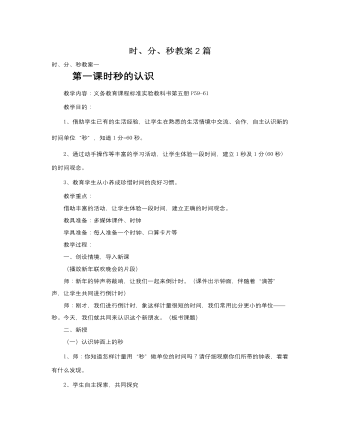
人教版新课标小学数学三年级上册时、分、秒说课稿2篇
教材分析这部分内容是在认识钟表上的整时、半时的基础上进一步认识钟面上的时、分。分是非常重要的时间单位,也是进一步学习年、月、日的基础。时间单位不像长度、质量单位那样容易表现出来,比较抽象,学生不容易理解。所以,应以学生的生活经验为基础,把学习内容与学生的生活实际密切联系起来,进行教学。“我们赢了”是结合“北京申奥成功”这一情境,让我们记住这一历史时刻——2001年7月13日晚上10时08分。用记载着这一历史时刻的钟面,引导学生交流自己对钟面的认识,激活学生已有的生活经验;同时,抓住机会渗透爱国主义教育,引导学生关注社会,关心时事。学情分析学生在一年级时已经学过了钟面的简单知识并会认识整时和整时半。但有关时间的认知显得有些混乱,对时针和分针表示的意义分辨不清,多数孩子还不能读出准确的时刻。
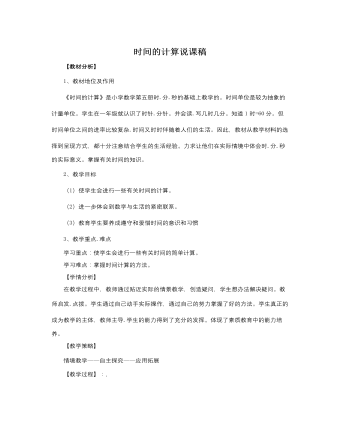
人教版新课标小学数学三年级上册时间的计算说课稿
【反思】本节课的教学注重体现了情境教学在教学中的运用。课堂上体现了这样几个特点:1.数学知识与生活实际相结合。数学来源于生活,生活中处处有数学。小学生对熟悉的生活情境和事物感兴趣。所以我从他们熟悉的事物中寻找教学题材,设计了有趣的情景教学。让学生感到数学知识就在他们身边,感到数学的作用,设计了作息时间表。这样,既巩固了时间的知识。又可以教育学生在生活中要合理安排时间,不要浪费时间,做时间的主人。2.注重在学习中自主探究,合作交流。在教学《时间的计算》时,让学生用自己制作的学具表亲自动手拨一拨,想一想让他们主动尝试自主发展。教学例2时让他们小组合作交流学习方法。这些都体现了培养学生的能力.自主探究的精神。
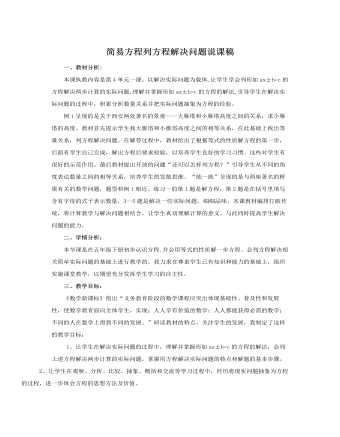
人教版新课标小学数学五年级上册简易方程列方程解决问题说课稿
设计意图:在游戏中巩固策略,提高学生学习兴趣,缓解学习疲劳。这个游戏的“揭密”过程关注方法的多样化,让学生体会列方程的策略和倒推策略之间的联系,把新旧知识进行了有机地融合,以培养学生思维的灵活性和发散性。四、课堂小结 提升策略提问学生:这节课你学会了应用什么策略解决实际问题?什么类型的题目适合用今天的策略解答?用这样的策略解决实际问题要注意什么?你还有别的收获吗?设计意图:突出主题,让学生总结本课的学习内容和学习重点;同时关注学生的个性发展,引导学生进行个性化的总结,体现不同层次的学生对课堂教学的领悟程度。五、课堂作业列方程解决实际问题,完成练习一4、5两题。设计意图:及时反馈学生学习情况,为后续教学研究收集宝贵的教学信息。
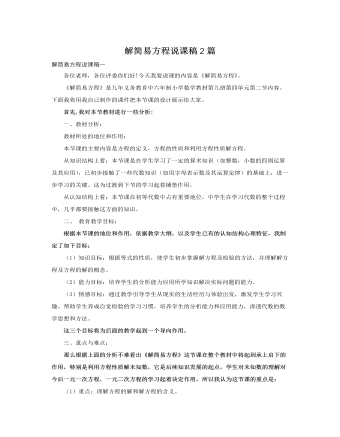
人教版新课标小学数学五年级上册解简易方程说课稿2篇
一、本节内容在教材中所处的地位和作用:本单元是在学生理解了四则运算的意义和学会用字母表示数的基础上进行学习的。由学习用字母表示数到学习方程,是学生又一次接触初步的代数思想,这既是对所学四则运算意义和数量关系的进一步深化,又是为今后学习代数知识作准备,在知识衔接上具有重要作用。而这一节恰好在这一单元之中起着承上启下的作用。二、 教学目标:1、在具体的活动中,体验和理解等式的性质,会用等式的性质解简单的方程。2、结合有关黔金丝猴的数量情况,对学生进行保护珍稀动物方面的教育。3、培养学生的观察、讨论、推理、合作交流能力。三、重点难点:重点:解简单方程、用方程解决问题。因为方程知识与现实生活联系比较紧密,同时是今后学习代数知识的基础,所以把解简单方程作为本节重点。
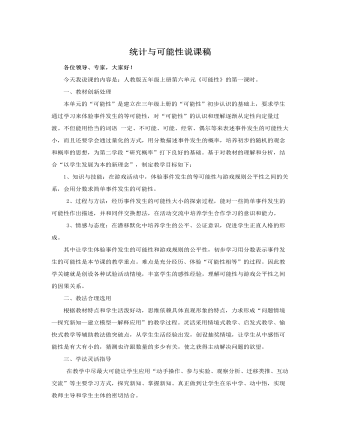
人教版新课标小学数学五年级上册统计与可能性说课稿
(设计意图:让学生充分表述自己的想法,强化学生的应用意识,培养学生解决实际问题的能力。从中发现可能性会随着数量的变化而变化的。)(四)归纳总结,完善认知1、学生汇报学习所得。(使学生体验探索成功的喜悦)2、教师评价学习态度。(让学生感受学习数学我能行)五、板书科学设计简单明了,重点突出,加深对所学知识的理解和掌握。通过以上创新处理,营造宽松的学习氛围,为学生创造联想猜测、动手操作、合作交流、自主探究、解决问题的机会,使学生在“自主——合作——探究”的学习过程中,体验数学探索成功的喜悦,体会到数学课堂充满生命的活力。以上是我对本节课的一些设想,还有待于在实践中去完善,如有不当之处,敬请各位专家评委给予批评和指正。
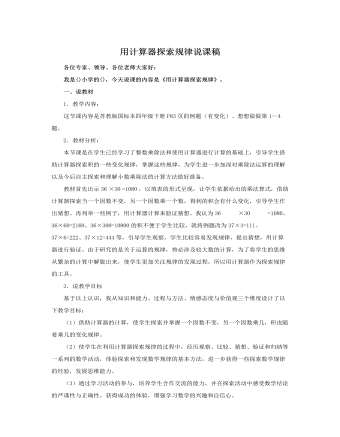
人教版新课标小学数学五年级上册用计算器探索规律说课稿
(3)补充题:2008年的奥运会在北京举行,小明的爸爸决定去北京观看一些比赛项目,为中国健儿加油。如果坐汽车,每小时行使60千米,4小时可以多少千米?如果坐火车,火车的速度是汽车的2倍,同样的时间可以行使多少千米?这题的第2个问题中蕴含着两种解题思路,让学生说一说、比一比。一种是根据速度×时间=路程的数量关系,先算出变化了的那个因数是多少,再求积。另一种是根据一个因数不变,另一个因数乘以几,原来的积也乘以几解决问题。两种方法得出的积相同,使学生体会积的变化规律是客观存在的普遍规律。『设计理念』在层次分明,形式多样的练习中,通过让学生想一想、填一填、说一说,使学生在规律的应用中逐步加深对积的变化规律的理解。
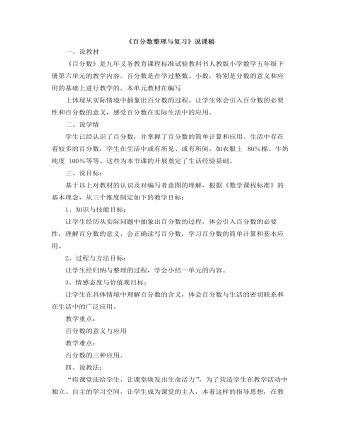
小学数学人教版六年级上册《百分数整理与复习》说课稿
一、说教材《百分数》是九年义务教育课程标准试验教科书人教版小学数学五年级下册第六单元的教学内容。百分数是在学过整数、小数,特别是分数的意义和应用的基础上进行教学的。本单元教材在编写上体现从实际情境中抽象出百分数的过程。让学生体会引入百分数的必要性和百分数的意义,感受百分数在实际生活中的应用。二、说学情学生已经认识了百分数,并掌握了百分数的简单计算和应用。生活中存在着较多的百分数,学生在生活中或有所见、或有所闻。如衣服上 80%棉、牛奶纯度 100%等等。这些为本节课的开展奠定了生活经验基础。
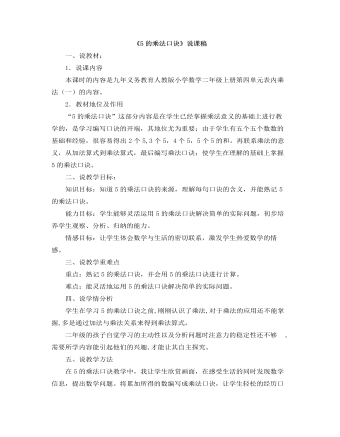
小学数学人教版二年级上册《5的乘法口诀》说课稿
1.说课内容本课时的内容是九年义务教育人教版小学数学二年级上册第四单元表内乘法(一)的内容。2.教材地位及作用“5的乘法口诀”这部分内容是在学生已经掌握乘法意义的基础上进行教学的,是学习编写口诀的开端,其地位尤为重要;由于学生有五个五个数数的基础和经验,很容易得出2个5,3个5,4个5,5个5的和。再联系乘法的意义,从加法算式到乘法算式,最后编写乘法口诀;使学生在理解的基础上掌握5的乘法口诀。二、说教学目标:知识目标:知道5的乘法口诀的来源,理解每句口诀的含义,并能熟记5的乘法口诀。能力目标:学生能够灵活运用5的乘法口诀解决简单的实际问题,初步培养学生观察、分析、归纳的能力。情感目标:让学生体会数学与生活的密切联系,激发学生热爱数学的情感。
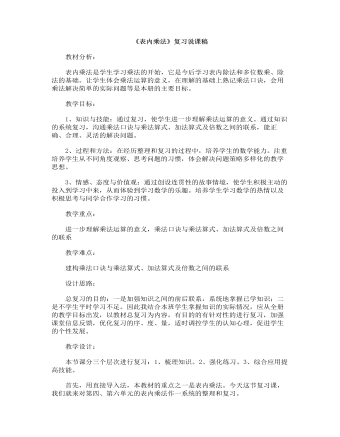
小学数学人教版二年级上册《表内乘法》复习说课稿
教学目标:1、知识与技能:通过复习,使学生进一步理解乘法运算的意义。通过知识的系统复习,沟通乘法口诀与乘法算式、加法算式及倍数之间的联系,能正确、合理、灵活的解决问题。2、过程和方法:在经历整理和复习的过程中,培养学生的数学能力。注重培养学生从不同角度观察、思考问题的习惯,体会解决问题策略多样化的教学思想。3、情感、态度与价值观:通过创设连贯性的故事情境,使学生积极主动的投入到学习中来,从而体验到学习数学的乐趣。培养学生学习数学的热情以及积极思考与同学合作学习的习惯。教学重点:进一步理解乘法运算的意义,乘法口诀与乘法算式、加法算式及倍数之间的联系教学难点:建构乘法口诀与乘法算式、加法算式及倍数之间的联系
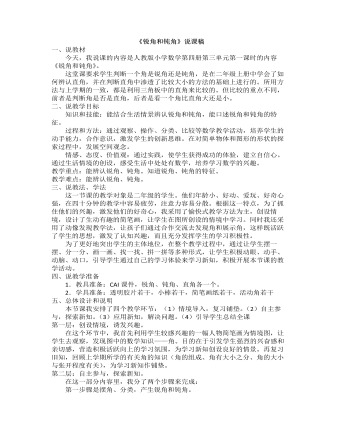
小学数学人教版二年级上册《认识锐角和钝角》说课稿
二、说教学目标知识和技能:能结合生活情景辨认锐角和钝角,能口述锐角和钝角的特征。 过程和方法:通过观察、操作、分类、比较等数学教学活动,培养学生的动手能力,合作意识,激发学生的创新思维。在对简单物体和图形的形状的探索过程中,发展空间观念。情感、态度、价值观:通过实践,使学生获得成功的体验,建立自信心。通过生活情境的创设,感受生活中处处有数学,培养学习数学的兴趣。教学重点:能辨认锐角、钝角。知道锐角、钝角的特征。教学难点:能辨认锐角、钝角。三、说教法、学法这一节课的教学对象是二年级的学生。他们年龄小、好动、爱玩、好奇心强,在四十分钟的教学中容易疲劳,注意力容易分散。根据这一特点,为了抓住他们的兴趣,激发他们的好奇心,我采用了愉快式教学方法为主,创设情境,设计了生动有趣的简笔画,让学生在图所创设的情境中学习。同时我还采用了动像发现教学法,让孩子们通过合作交流去发现角和展示角,这样既活跃了学生的思想,激发了认知兴趣,而且充分发挥学生的学习积极性。
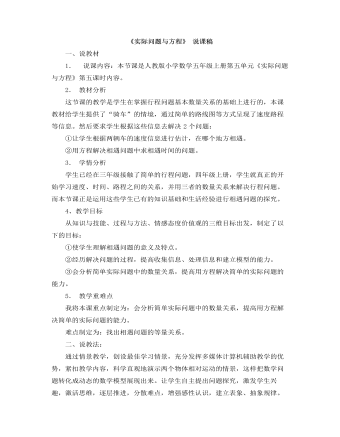
小学数学人教版五年级上册《实际问题与方程 》说课稿
2. 教材分析这节课的教学是学生在掌握行程问题基本数量关系的基础上进行的,本课教材给学生提供了“骑车”的情境,通过简单的路线图等方式呈现了速度路程等信息。然后要求学生根据这些信息去解决2个问题:①让学生根据两辆车的速度信息进行估计,在哪个地方相遇。②用方程解决相遇问题中求相遇时间的问题。3. 学情分析学生已经在三年级接触了简单的行程问题,四年级上册,学生就真正的开始学习速度、时间、路程之间的关系,并用三者的数量关系来解决行程问题。而本节课正是运用这些学生已有的知识基础和生活经验进行相遇问题的探究。4、教学目标从知识与技能、过程与方法、情感态度价值观的三维目标出发,制定了以下的目标:①使学生理解相遇问题的意义及特点。②经历解决问题的过程,提高收集信息、处理信息和建立模型的能力。③会分析简单实际问题中的数量关系,提高用方程解决简单的实际问题的能力。

